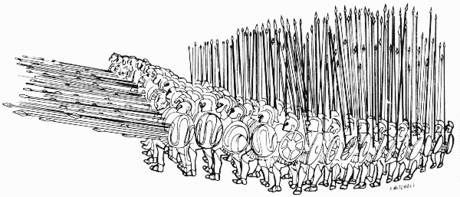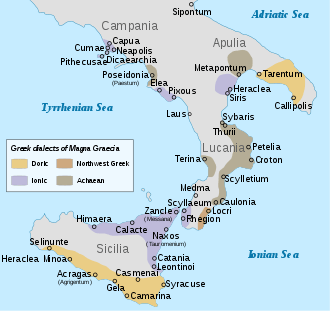Sarissa
The sarisa or sarissa (Greek: σάρισα) was a long spear or pike about 4–6 metres (13–20 ft) in length. It was introduced by Philip II of Macedon and was used in his Macedonian phalanxes as a replacement for the earlier dory, which was considerably shorter. These longer spears improved the strength of the phalanx by extending the rows of overlapping weapons projecting towards the enemy, and the word remained in use throughout the Byzantine years to sometimes describe the long spears of their own infantry.[1][2]
Composition and utility
The sarissa, made of tough and resilient cornel wood, was very heavy for a spear, weighing approximately 5.5 kg (12 lb) to 6.5 kg (14 lb).[3] It had a sharp iron head shaped like a leaf and a bronze butt-spike which could be anchored in the ground to stop charges by the enemy.[4] The spike was sharpened well enough to pierce an enemy shield.[5] The bronze material of the butt-spike prevented it from rusting. The spike also served to balance out the spear, making it easier for soldiers to wield, and could be used as a back-up point should the main one break.
The sheer bulk and size of the spear required the soldiers to wield it with both hands, allowing them to carry only a 60 cm (24 in) shield (pelta) suspended from the neck to cover the left shoulder.[6] Its great length was an asset against hoplites and other soldiers bearing shorter weapons, as they had to get past the sarissas to engage the phalangites. However, outside the tight formation of the phalanx, the sarissa was of limited utility as a weapon and a hindrance on the march. As such, it was usually composed of two lengths and was joined by a central bronze tube only before a battle.[7] The two parts were carried on the soldier's back during these marches.[5]
Tactics
Complicated training ensured that the phalanx wielded their sarissas in unison, swinging them vertically to wheel about, then lowering them to the horizontal. The uniform swish of the sarissas daunted the Illyrian hill tribesmen against whom the young Alexander fought in an expedition early in his reign.[8]
The sarissa-bearing phalanx would usually march to battle in open formation to facilitate movement. Before the charge, it would tighten its files to close formation or even compact formation (synaspismos). The tight formation of the phalanx created a "wall of pikes", and the pike was so long that there were fully five rows of them projecting in front of the front rank of men—even if an enemy got past the first row, there were still four more to stop him. The back rows bore their pikes angled upwards in readiness, which served the additional purpose of deflecting incoming arrows.[9] The Macedonian phalanx was considered invulnerable from the front, except against another such phalanx; the only way it was generally defeated was by breaking its formation or outflanking it.
History of use
The invention of the sarissa is credited to Philip II, father of Alexander the Great. Philip drilled his soldiers, whose morale was at first low, to use these formidable pikes with two hands. The new tactic was unstoppable, and by the end of Philip's reign the previously fragile northern Greek kingdom of Macedon controlled the whole of Greece and Thrace.
His son, Alexander, used the new tactic across Asia, conquering Egypt, Persia and the Pauravas (northwest India), victorious all the way. The sarissa-wielding phalanxes were vital in every early battle, including the pivotal Battle of Gaugamela where the Persian king's scythe chariots were utterly destroyed by the phalanx, supported by the combined use of companion cavalry and peltasts (javelineers). During his later campaigning, Alexander gradually reduced the importance of the phalanx and the sarissa, as he modified his combined use of arms to incorporate 'Asian' weapons and troops, not specifically trained in Hellenistic battle tactics.
The sarissa, however, remained the backbone for every subsequent Hellenistic, and especially Diadochi army. The Battle of Raphia between the Seleucids and Ptolemy IV may represent the pinnacle of sarissa tactics, when only an elephant charge seemed able to disrupt the opposing phalanx. The Successor Kingdoms of Macedon's empire tried expanding upon the design, creating pikes as long as 6.75 m (22.1 ft), but all of these ideas were eventually abandoned in favor of the battle-tried Philippine-Alexandrian sarissa. Battles often ended up stalemated in what Oliver Cromwell later described as "the terrible business of push of pike".
Subsequently, a lack of training and too great a reliance on the phalanx instead of the combined use of arms (Alexander's and Philip's great contributions) led to the final defeat of Macedon by the Romans at the Battle of Pydna. Modern conclusions are that the loss was actually due to a failure of command on the part of Perseus, as well as the peculiar stance of the Companion cavalry, who did not engage the enemy. Part of the reason for the rapid deterioration of the sarissa's ability was that, after Alexander, generals ceased to protect phalanxes with cavalry and light-armed troops, and phalanxes were destroyed too easily by flank attacks owing to the sarissa's tactical unwieldiness. The sarissa was gradually replaced by variations of the gladius as the weapon of choice. Only Pyrrhus of Epirus was able to maintain a high standard of tactical handling with armies based around the sarissa, but with the dawn of the manipular system, even he struggled for his victories.
See also
- Ancient Macedonian military
- Battle of Chaeronea (338 BC)
- Dory (spear)
- Pole weapon
- Sarissophoroi
- Wood economy
- Xyston
Notes
- 11th century, Michael Attaleiates, The History, A.1047
- 6th century, Agathias Scholasticus, Histories, B.43
- Markle 324
- Fox76f.
- Jannik Pettersen (2020). "Jättelansar höll fienden på avstånd" [Giant spears kept the enemy at a distance]. Världens Historia (in Swedish). No. 2. Bonnier Publications International. p. 72. ISSN 0806-4709.
- Markle 326
- Fox, p. 75
- Described by Fox, pp 84f.
- Anthony, Matthew, Christopher (2015). An invincible beast : understanding the Hellenistic pike-phalanx at war. Barnsley, South Yorkshire: Pen and Sword Military. p. 397. ISBN 9781473881341. OCLC 951434590.
References
- Lane Fox, Robin (1973). Alexander the Great. Penguin. ISBN 0-14-008878-4.
- M. Markle, III, Minor (Summer 1977). "The Macedonian Sarrissa, Spear and Related Armor". American Journal of Archaeology. Archeological Institute of America. 81 (3): 323–339. doi:10.2307/503007. JSTOR 503007.
- Campbell, Duncan B. (2014). "How long was the Macedonian sarissa?". Ancient Warfare. Karwansaray Publishers. VIII (3): 48–52.

